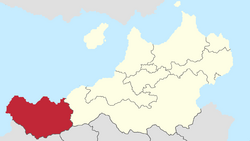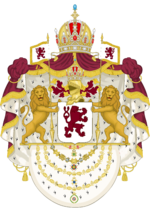Ruttland: Difference between revisions
Britbong64 (talk | contribs) No edit summary |
Britbong64 (talk | contribs) No edit summary |
||
| Line 94: | Line 94: | ||
===Middle Ages=== | ===Middle Ages=== | ||
===Kirenian Rule=== | ===Kirenian Rule=== | ||
[[File:Emila Plater conducting Polish scythemen in 1831.jpg|250px|thumb|[[Nida Jurgaitytė]] led the unsuccessful [[ | ===Kingdom=== | ||
[[File:Emila Plater conducting Polish scythemen in 1831.jpg|250px|thumb|[[Nida Jurgaitytė]] led the unsuccessful [[Jurgaitytė rebellion]] from 1861.]] | |||
=== | As part of the Congress of Torazza that ended the [[War of the Triple Alliance]] Ruttland was annexed into Werania in February 1856. The annexation was of the entire "Greater Ruttland" region including the modern day free state and the majority Weranian Zinngebirge Basin. The region was at the time ethnically diverse with a weak national identity, with the upper landowning classes tending to speak both Kirenian and Ruttish, the middle commercial classes Weranian and peasantry Ruttish. | ||
The new Ruttish state was officially made a kingdom in a {{wp|personal union}} with Cislania. The 1856 constitution of the kingdom was highly illiberal; the kingdom was to be ruled by a representative of the king known as a ''{{wp|reichsstatthalter}}'' who would effectively rule by decree. The centuries old seimas was replaced by a ''landtag'' that would be appointed by the ''reichsstatthalter'' whilst Weranian was made the sole language of administration. The first ''reichsstatthalter'' Hans Wilhelm von Weikersthal embarked on a policy of {{wp|Germanisation|Weranicisation}} that intended to wipe out the Ruttish language and integrate Ruttland as a fully Weranian province of the confederation. However Weranian rule soon became unpopular when the abolition of protectionist tariffs in line with integrating Ruttland into Werania's industrial free market economy caused Ruttland's agrarian economy to collapse causing a rise in banditry and discontent with Weranian rule. This culminated with the Jurgaitytė rebellion led by Ruttish noblewomen Nida Jurgaitytė to break out in June 1861 which initially saw Ruttish revolutionary forces beat back the larger, better armed Weranian army - however by the autumn of 1861 the rebellion had declined and in October 1861 where defeated. | |||
The defeat of the Jurgaitytė rebellion would see changes in the province. Rather then rely on Cislanian bureaucrats to run the province the Weranian government increasingly relied on the Weranian bourgeoise in the province to govern it. The ''landtag'' was elected rather then appointed and the position of ''reichsstatthalter'' filled by Weranians from the province. Land reforms passed by the new provincial government encouraged rural-to-urban migration and the growth of urban industrial centres with the intention of sponsoring "soft Weranicisation". As a result the 1860's saw Ruttland go through a high period of growth with the city of Šilokrautė (Bereheim) becoming Werania's largest port city. | |||
===Free State=== | |||
==Government and Politics== | ==Government and Politics== | ||
===Government=== | ===Government=== | ||
Revision as of 16:41, 15 July 2021
Free State of Ruttland
| |
|---|---|
| Anthem: O, brangioji giraitės medis Oh dear rowan tree | |
 | |
| Country | Werania |
| Status | Free state within a federal monarchy |
| Annexation into Werania | 1850 |
| Free State | 1986 |
| Capital | Lipliškės |
| Government | |
| • Type | Devolved parliamentary republic in a federal monarchy |
| • Body | Seimas |
| • Minister-Chairman | Žygimantas Navikas |
| Population (2018) | |
| • Total | 10,792,847 |
| Demonym | Ruttish |
| GDP | |
| • Total | $399,140 million |
| • Per capita | $36,981 |
| Area code | +893 |
| Official languages | Ruttish Weranic |
The Free State of Ruttland (Ruttish: Nemokama Ruttųijos Valstybė) is a constituent state within the Weranian Confederation. It borders Cislania to the east and has an international border with Kirenia to the west. It has a population of 10,792,847 and its capital is Lipliškės whilst its largest city is Šilokrautė.
The presence of Ruttish people in the area dates back to the 3rd millennium BC. Under the Solarians Ruttish tribes were never conquered rather existing as tribal, pagan societies that were not united under any single authority. In the 1000's Ruttland was united under the Kingdom of Ruttland which existed as one of the last major pagan sites in Euclea across both parts of modern day Werania and Kirenia. In 1254 King Vilimas I defeated the Rudolphine Confederation becoming its Emperor, but his dynasty would prove short lived. Parts of Ruttland would subsequently ruled both by the Kirenian Maritime League and Gallic North Sea Empire.
Ruttland continued to exist within the confederation as its most important non-Weranic member, even maintaining a small colonial empire, Aucuria. Fiscal mismanagement, and governmental instability weakened Ruttland over the 1700's. During the Ten Years' War Ruttland was one of the leaders of the anti-Cislania coalition but ultimately lost the war being annexed into Kirenia. Under Kirenian war Ruttland became one of the wealthier parts of the nation with a distinct Rutto-Kirenian culture emerging as a result.
After the War of the Triple Alliance the province of Ruttland ceded to Werania where it became the Kingdom of Ruttland which was in personal union with the Kingdom of Cislania, the main component of the Weranic state. Ruttland was ruled in an authoritarian manner in a period known as "Reichsstatthalter rule" which saw a programme of Weranicisation being carried out. This ignited the Ruttish national revival which at first attempted to secede Werania in the Jurgaitytė rebellion before focusing on cultural nationalism and attempting to achieve autonomy. An unrepresentative voting system that benefited ethnic Weranics compounded this sentiment, making the "Ruttish question" one of the defining political issues of the 1800's and early 1900's in Werania.
During the Great War Ruttland was the site of the collaborationist Lipliškės Government. Following the war the Weranic dominated landtag was dissolved being replaced with the seimas which subsequently implemented policies reversing Weranicisation instead emphasising religious conservatism to combat left-wing ideologies. The Kirenian-Ruttish War saw Ruttland lose the majority Weranian Zinngebirge Basin making the region more homogenous Ruttish as a result. The province would continue to agitate for a strong regional identity leading to in 1986 a successful push by the central government to devolve more power to the region and formally end the monarchy in Ruttland, with the province becoming a free state.
Famed historically for its large steel industry, since deindustrilisation Ruttland has suffered from higher unemployment and lower living standards than the rest of Werania. Ruttland has however undergone a cultural revival in recent years with its largest city Šilokrautė being considered one of the most vibrant cities in the country.
History
Prehistory
Early history
Middle Ages
Kirenian Rule
Kingdom
As part of the Congress of Torazza that ended the War of the Triple Alliance Ruttland was annexed into Werania in February 1856. The annexation was of the entire "Greater Ruttland" region including the modern day free state and the majority Weranian Zinngebirge Basin. The region was at the time ethnically diverse with a weak national identity, with the upper landowning classes tending to speak both Kirenian and Ruttish, the middle commercial classes Weranian and peasantry Ruttish.
The new Ruttish state was officially made a kingdom in a personal union with Cislania. The 1856 constitution of the kingdom was highly illiberal; the kingdom was to be ruled by a representative of the king known as a reichsstatthalter who would effectively rule by decree. The centuries old seimas was replaced by a landtag that would be appointed by the reichsstatthalter whilst Weranian was made the sole language of administration. The first reichsstatthalter Hans Wilhelm von Weikersthal embarked on a policy of Weranicisation that intended to wipe out the Ruttish language and integrate Ruttland as a fully Weranian province of the confederation. However Weranian rule soon became unpopular when the abolition of protectionist tariffs in line with integrating Ruttland into Werania's industrial free market economy caused Ruttland's agrarian economy to collapse causing a rise in banditry and discontent with Weranian rule. This culminated with the Jurgaitytė rebellion led by Ruttish noblewomen Nida Jurgaitytė to break out in June 1861 which initially saw Ruttish revolutionary forces beat back the larger, better armed Weranian army - however by the autumn of 1861 the rebellion had declined and in October 1861 where defeated.
The defeat of the Jurgaitytė rebellion would see changes in the province. Rather then rely on Cislanian bureaucrats to run the province the Weranian government increasingly relied on the Weranian bourgeoise in the province to govern it. The landtag was elected rather then appointed and the position of reichsstatthalter filled by Weranians from the province. Land reforms passed by the new provincial government encouraged rural-to-urban migration and the growth of urban industrial centres with the intention of sponsoring "soft Weranicisation". As a result the 1860's saw Ruttland go through a high period of growth with the city of Šilokrautė (Bereheim) becoming Werania's largest port city.
Free State
Government and Politics
Government
Legislature
 |
|
RSDT: 7 seats Greens: 9 seats SDRP-DS: 12 seats NNK: 70 seats SDT: 16 seats NKP: 11 seats |




